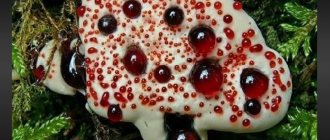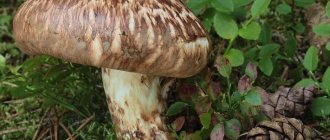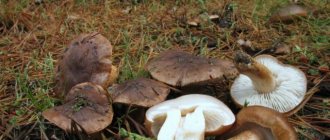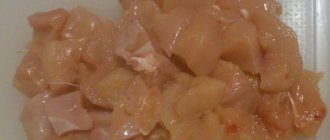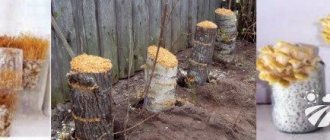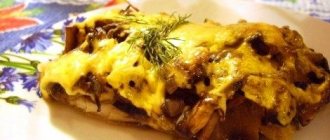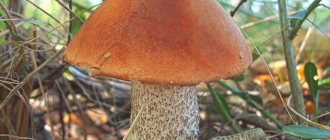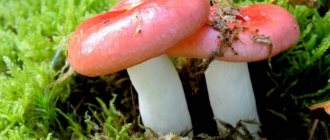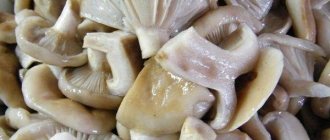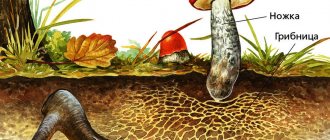Matsutake is a mushroom belonging to the genus Ryadovka. The specimen is valued in Korean, Japanese and Chinese cuisine. Matsutake mushrooms or “shod row” mushrooms are a rare species that is often equated to truffles. Experienced mushroom pickers also collect matsutake in Russia, but the location of the species is kept strictly secret.
Mushrooms
The main photo shows matsutake mushrooms, which were mentioned in the title of the article. They are native to Japan and some Asian countries. Recently, their number has decreased noticeably. The reason for this is harmful insects that destroy trees in whose shade matsutake appear.
Botanists predict that these mushrooms may soon disappear from the face of the Earth, since there are no artificial methods of growing this delicacy. Due to the fact that these mushrooms have become rare, the price per kilogram exceeds $600. They must probably taste incredible and have numerous beneficial properties, otherwise why are they so expensive?
For those who have trouble with self-organization: how to get ready to work from home
Additional days off: how an employer can retain old employees
Ignoring or achieving a goal: the difference between workaholism and success
The picture below shows white truffles. Although, to be honest, they are more reminiscent of ginger. Don't you think so?
In Europe, white truffles sell for 2,000 euros per 1 kg. This incredible cost is due to various reasons:
- specific growing conditions
- special collection and storage method
- refined taste
- unsurpassed aroma
I hope the taste of white truffles is really worth the money.
Distribution and collection
The row is spotted.
Matsutake is common in Asian countries, Finland and Sweden, southern Russia and North America. The fungus prefers dry, depleted soils, and if there is a little more humus in the soil, matsutake will not grow there. Mycorrhiza formation with certain tree species depends on the area.
The fruiting period for rows of this species is the beginning of autumn.
The row is tied.
Meat delicacies
Japanese marbled beef is the most expensive and exquisite meat delicacy in the world. Its uniqueness lies in its amazing aroma, high level of marbling and famous oily structure. If you want to cook cutlets or steak from this meat, you will have to pay $450 per kilogram.
When choosing sausages in a supermarket, you don’t even suspect that the prices before your eyes are significantly lower than the cost of this delicacy. The most expensive ham is made in Spain from the meat of black Iberian pigs. The animals are fed only acorns and walked on special pastures. For 1 kilogram of this ham, a gourmet will be asked for about 370 euros.
Interesting Facts
The row is shod.
Matsutake is valued not only for its taste and smell, but also for its healing properties.
This mushroom is capable of:
- Regulate blood sugar.
- Prevent the appearance of cancerous tumors.
- Normalize blood pressure.
- Fight viruses.
By the way, in Chinese folk medicine, matsutake row is used as an analgesic, sedative, and also for diseases of the digestive system. This mushroom has also been used in cosmetology as a lightening agent; in addition, it has a generally healing effect on the skin.
Poultry meat
Ayam Chemani chickens are raised in Indonesia. They are unusual in that they are completely black not only on the outside, but also on the inside. Birds have black meat and even bones. You can see this in the photo below:
The meat of these birds is not exported to other countries, as there is a danger of the spread of bird flu. In the country where it is raised, a chicken is valued at about $200. In other states, the price can increase to several thousand dollars. I wonder how much a similar black chicken thigh dish would cost?
Swallow's nest soup will be very expensive for lovers of gourmet food, because one kilogram can cost about 3 thousand dollars. Swallow's nests are a popular Chinese delicacy. They are almost 100% pure bird saliva with no added plants.
Those who like to go out at someone else's expense: types of friends who provoke unnecessary spending
What benefits may appear in the future in the Russian Federation for buyers of electric vehicles?
Sting sold the rights to all his songs for $250 million
How to explain such a high price? Collecting swallow nests is associated with great risk. Because birds place their homes on rocks - foragers can fall off steep cliffs into the abyss.
Description
Matsutake is a name translated from Japanese as “pine mushroom”, since this row usually produces mycorrhiza with pine.
hat
Matsutake.
The matsutake hat, depending on age, has a shape from hemispherical to almost flat. The edges of the cap are turned down.
The hat is small and brown. The color of the cap is uneven, its surface is dry and smooth, in mature specimens it cracks and the flesh is visible through the cracks.
Leg
The stem of matsutake can reach a considerable length (up to 25 cm), and its thickness is about 3 cm. The stem is usually very deeply rooted in the ground, so getting this mushroom “from the roots” is not an easy task.
The color of the leg is brownish-white, its surface is completely covered with brownish scaly growths. In the upper part of the leg there is a ring-shaped outgrowth from a torn veil. This growth is uneven, fragmented, and brown in color. Above it, the leg is covered with a coating similar to flour.
The row is shod.
Spore-bearing layer
Hymenophore matsutake lamellar. In most specimens the hymenophore is covered by fragmentary remains of velum. The plates are white or slightly yellowish, and with mechanical damage they change color to brown.
Pulp
Matsutake pulp is white and thick. It emits a pleasant aroma, simultaneously similar to pear, cinnamon and pine needles. The mushroom tastes pleasant with a bitter aftertaste.
Spore powder
Matsutake spores are small, round and brown in color. The bulk of the powder is brown.
A few more examples
Surely you have heard about the spice saffron. 1000 grams of this seasoning can cost 400-1000 dollars. Why so expensive? Saffron flowers bloom in the fall and last only a week. During this time, pickers must manually collect and process the material. But what’s most interesting is that to collect 1 kg of saffron, you will need approximately 300 thousand flowers of a unique plant.
Have you seen what moose milk cheese looks like? If not, then watch it.
This snow-white cheese is one of the most expensive cheeses in the world. It is made in only one place - on a moose farm in Sweden. This delicacy is produced in very limited quantities, mainly to order. The cost of 1 kilogram, just think about it, is 1000 euros.
And the last item on the list of the most expensive food is COPI Luwak coffee. Its uniqueness lies in its special form of processing. The most expensive coffee in the world is produced on an industrial scale in the Philippines, South India and Indonesia. The price varies between 250-1200 dollars per 1000 grams.
Found a violation? Report content
Calorie content and chemical composition
Content:
- Calorie content and chemical composition
- Useful properties of Japanese truffle
- Contraindications for use and harm
- In Matsutake cooking
Matsutake forest mushrooms are among the most expensive mushrooms in the whole world. The product has incredible nutritional and healing properties, a low-calorie product with a minimal amount of fat.
The product contains one and a half grams of fructose and 0.2 grams of glucose per hundred grams of mushrooms. Japanese truffle has a rather complex chemical composition.
Vitamins PP, D7, , , , group B, betaine. Thanks to this amount of vitamins, the product is able to normalize the functioning of the entire body. Matsutake pine mushrooms contain folic acid, which is necessary for the human body, which is responsible for the full functioning of the reproductive system and the usefulness of metabolic processes.
Magnesium – thanks to this component, the functioning of the gastrointestinal tract and the functioning of the cardiovascular system are improved, it allows you to relax the central nervous system, suppress a depressive state, and feel at ease.
Potassium - this important substance is responsible for normalizing the acid-base balance.
Antibiotics of natural origin - fomecin and clitocin - can effectively fight viral bacteria and cancer cells.
Protein – the product is filled with proteins; protein is the main component for the renewal of cells and tissues of the human body.
Polysaccharides are carbohydrates that directly have a positive effect on the functioning of the kidneys, liver and gastrointestinal tract, and also stimulate the functioning of the endocrine and immune systems.
Lecithin is an important and useful organic substance that cleanses the body of cholesterol and prevents it from accumulating again.
Ergothioneine is a powerful antioxidant of plant origin that has a protective effect on skin cells.
Matsutake is more similar in its chemical composition to meat. It follows from this that vegetarians are simply recommended to add this product to their diet to provide the body with all the nutritional and vital components.
Table of calorie content and BZHU
Nutritional value per 100 grams (based on 100 grams of product)
| Calorie content | 28 kilocalories |
| Squirrels | 3.9 grams |
| Fats | 0.7 grams |
| Carbohydrates | 1 gram |
| Ash | 0.8 grams |
| Water | 89.5 grams |
| Alimentary fiber | 1.2 grams |
The energy ratio of BJU can be compared (in percentage): 56/23/14.
Useful properties of Japanese truffle
Its beneficial properties of the product are known, including:
- a low-calorie product with minimal fat content, which in turn allows you to adjust your weight without harm to your health;
- allows you to remove free radicals from the body, which adversely affect the functioning of the entire body;
- helps normalize blood sugar levels, very useful for people with diabetes;
- the product contains a rich vitamin composition, which in turn stimulates the immune system, increasing the body's resistance to viral bacteria;
- has anti-cancer properties, especially helps to cope with blood diseases (leukemia), the product is used for treatment in its raw form;
- has a preventive effect on the body against viral and respiratory diseases.
Contraindications for use and harm
Regardless of the wide range of positive properties of the product, there are certain contraindications for its use, namely:
- The product must be consumed exclusively fresh; if it is stored for a long time, it begins to produce harmful toxins, which in turn can cause serious poisoning.
- The product can cause severe allergic reactions, therefore, before consuming such an exotic and expensive product, you need to do a small test to determine the body’s sensitivity to the product.
- If the body has abnormalities in the gastrointestinal tract, or serious diseases of the gastro-digestive system, the product is not recommended to be included in the diet. People with pancreatitis and gallbladder dysfunction should also avoid Japanese truffle.
- If for some reason poisoning with matsutake wild mushrooms occurs, the following symptoms are observed: active salivation (the abundant flow of saliva does not stop, even during food intake); nausea or severe vomiting (symptoms are not relieved by conventional anti-nausea medications); diarrhea (the symptom is not removed by usual medications). If at least one symptom appears, it is recommended to immediately consult a doctor.
